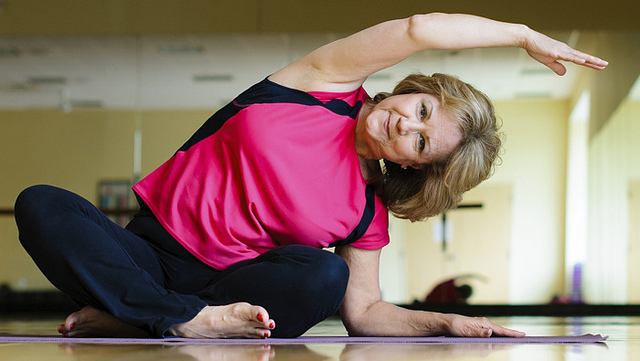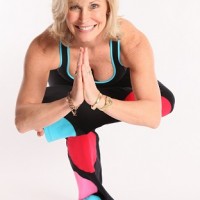[*Editor’s Note: elephant journal articles represent the personal views of the authors, and can not possibly reflect elephant journal as a whole. Disagree with an Op-Ed or opinion? We’re happy to share your experience here. This website is not designed to, and should not be construed to, provide medical advice, professional diagnosis, opinion or treatment to you or any other individual, and is not intended as a substitute for medical or professional care and treatment. For serious.]
~
Menopause itself is simply the moment that menstruation ceases.
However, the transition can be difficult and generally lasts at least several years.
Peri-menopause is the time leading up to that point, and typically occurs in women between the ages of 42 and 55, but it can affect women from 35 to 65 years of age. During peri-menopause, various uncomfortable symptoms occur and are triggered by the fluctuating levels of progesterone and estrogen.
Some of the most common symptoms are anxiety, irritability, insomnia, hot flashes, vaginal dryness, low libido, depression, mood swings, erratic menstrual cycles, acne and memory lapses.
An estimated 55-65 percent of women experience menopause related symptoms. What is happening during this time? The hypothalamus is a small structure at the base of the brain that regulates many bodily functions, including the menstrual cycle. This gland signals the pituitary gland to produce important hormones, and those hormones stimulate production of progesterone and estrogen in the ovaries.
During peri-menopause, the pituitary gland and ovaries have difficulty communicating because the ovaries decrease hormone production, while the pituitary gland, sensing low hormone levels, continues to encourage the ovaries to do their job. This struggle causes erratic fluctuations which create too much estrogen, revving up the body’s motors, followed by progesterone spikes, which slows the body down.
“Hormones are very powerful, they affect just about every tissue of the body. So its no wonder that various conditions can arise as the body tries to adjust to these hormonal shifts.” says Nancy Lonsdorf, M.D., author of A Woman’s Best.
A woman typically experiences hormonal fluctuation about six years before her menstrual period ends. After menopause, the ovaries produce less of the female hormones. However, the body still needs some estrogen to keep the bones healthy and to prevent conditions like osteoporosis and vaginal dryness. The adrenal glands are important because they secrete low levels of male hormones which are converted by fat cells into estrogen. The body, however, must adjust to much lower hormone levels.
How yoga can help:
Yoga instructor Catherine de los Santos practiced yoga in her 30’s to boost her confidence. In her 40’s, when hot flashes hit, she used various yogic practices to help her manage flashes. At 55, yoga helped her get through menopause and the emotional upheavals that came when her parents died.
She says, “I think the key is to not stop practicing,” and that “weaving your poses around your life is a good idea.”
“Yoga has important elements for all phases of a woman’s life” says Louann Brizendine, a neuropsychiatrist at the University of CA at San Francisco. “During times of radical hormonal changes, women feel least inclined to practice yoga, but that’s when we need it the most.”
Those changes in body chemistry can wreak havoc on our mood, but according to Dr. Brizendine, who wrote The Female Brain, “There is good evidence that during a practice like yoga, your body releases chemicals into the bloodstream that bring you a sense of well being and contentment.”
Self awareness in adapting our yoga practice with what’s happening in our lives, in our bodies and with our emotions is the key to benefiting from yoga. A consistent mindful yoga practice supports women spiritually, physically and emotionally at any age.
A recent Mayo Clinic Staff report suggests practicing relaxation techniques, not smoking, eating a healthy diet, and regular exercise (all of which help protect against heart disease, diabetes, osteoporosis and other conditions associated with aging).
Ayurveda, traditional eastern medicine, is based on the idea of balance in bodily systems and uses diet, herbal treatment, and yogic breathing. Adapting Ayurvedic practices and medicine may also be beneficial to those with menopausal symptoms.
Avoiding spicy foods, caffeine, alcohol and hot drinks may ease hot flashes and insomnia.
A study, which was published in the journal Menopause, found that women who attended yoga classes experienced less insomnia than the control group of women who did not practice yoga. “Many women suffer from insomnia during menopause, and it’s good to know that yoga may help them,” says Katherine M. Newton, PhD, a senior investigator at Group Health Research Institute in Seattle.
Researchers asked the women to attend weekly 90 minute yoga classes for 12 weeks, as well as maintain a daily home practice consisting of 11to 13 poses, deep relaxation and Yoga Nidra. The study proved that yoga is beneficial for insomnia, but did not have a significant benefit for hot flashes or night sweats.
Yoga Nidra is an ancient practice that is rapidly gaining popularity in the West, also known as sleep with awareness, or yogic sleep. The intent is to induce full-body relaxation and a deep meditative state of consciousness. “We live in a chronically exhausted, overstimulated world,” says Rod Stryker. “Yoga Nidra is a systematic method of complete relaxation, holistically addressing our physiological, neurological, and subconscious needs.”
Yoga poses that can help:
Restorative poses with props have proven beneficial, while on some days a more dynamic practice is preferred, combined with breathing techniques and meditation to help bring joy, quiet and acceptance to the mind and body.
- Supported Forward Bend: leaning against a wall, allow the head to hang but rest the head on a block to stimulate the pituitary gland
- Seated Revolved Head to Knee Pose (Parivrtta Janu Sirsasana): Helps calm emotions during intense hormonal shifts.
- Legs up the Wall: Helps relieve stress, mild depression and menopausal symptoms.
- Supported Bound Angle Pose (Supta Baddha Konasana): Keeps joints supple and frees abdomen, uterus, ovaries and vagina in this position.
- Supported Bridge Pose on 1 or 2 bolsters (Setu Bandha Sarvangasana): Helps prevent low back pain.
- Supported Child’s Pose using a bolster or blankets under the chest and stomach (Balasana).
- Relaxation Pose using a bolster under the knees and a small pillow under the neck (Savasana).
“My prescription for reducing stress in your life: decide here and now that you are your own first priority,” says Judith Hanson Lasater, PhD, PT, author of Living Your Yoga and Relax and Renew.
Some of her tips for relaxing are:
- Giving ourselves gentle reminders, such as asking for help when it’s needed.
- Make a plan to relax, such as treating ourselves to a massage.
In Yoga as Medicine, by Timothy McCall, M.D., Elise Browning Miller, a senior certified Iyengar yoga teacher states:
“Menopause is a time of change and change, yoga teaches, is inevitable. Coping with unwanted change is above all a spiritual issue. It’s hard when we go through menopause to acknowledge that we’re getting older. Yoga’s emphasis on meeting challenges with acceptance and gratitude acts as an antidote to these negative, self-defeating attitudes.”
~
~
~
Love elephant and want to go steady?
Sign up for our (curated) daily and weekly newsletters!
Apprentice Editor: Karissa Kneeland / Editor: Emily Bartran
Photo: flickr











Read 0 comments and reply